KDE5, KDE6, tiling and other rants
To some extent, this is a sort of follow-up to the previous extra-long feature Epic disappointments with Linux (not for the mentally retarded), which proved to be too complex a reading for most of the few humans who landed on that page. The 25 subchapters don’t help that much, and this is why I added a list of the discussed topics, as a comment and also here. It didn’t help much nowadays’ people, with their goldfish-like ability to focus.

Tiling is important, and not just in your bathroom
I wanted to write about the tiling introduced by KDE 5.27, but unforeseen circumstances made me deprioritize it. I was reminded of the issue by the YouTuber who goes by the moniker of Trafotin: KDE KILLED My One True Love… …which is Bismuth, a tool that implements automatic window tiling in KDE Plasma 5.20 or higher… …but which stopped working properly since KDE 5.27.
A user says: “i’m running kde 5.27 on kde btw and bismuth is working”; another comments: “1 program does not work properly in KDE, let’s switch to mac instead.”
The developer of Bismuth stopped developing it: “This repository has been archived by the owner on Jun 16, 2024. It is now read-only.” Here’s why:
Bismuth … is fundamentally incompatible by design with the new KWin feature and needs a rewrite from the ground up. … I am not so good at rewrites, primary because it is a very time-consuming task, which is impossible to do because … my lifestyle changed drastically in the recent year, so I have new things to do and discover. … I do not use KDE Plasma anymore, because it is no longer works for me as a technical solution for my problems …
A bit strange, if you ask me.
But let’s mention the tiling introduced by KDE 5.27! Video taken from the official announcement:
The feature has actually been announced in 5.26.90 (5.27 Beta), as the KWin Tiling System. But there are no official tutorials. This is their official guidance, in full:
Check out the new tiling system: it will allow you to set up custom tile layouts and resize adjacent tiled windows simultaneously. Activate it in System Settings > Workspace Behavior > Desktop Effects and then you can tile a window dragging it while holding down the Shift key. To create custom tile layouts, hold down the Meta (“Windows“) key, and then press T.
As for me, I discussed window tiling in 2021: What Reddit has taught me about Arch Linux. To start with a bold statement:
I don’t understand why some people would need automatic tiling (normal people don’t, as predefined and continually decreasing window sizes can’t be optimal for anything!); what I’d need was decent on-demand tiling.
As I wrote back then, Windows 1.0 was a tiling window manager (quite decent for 1985):
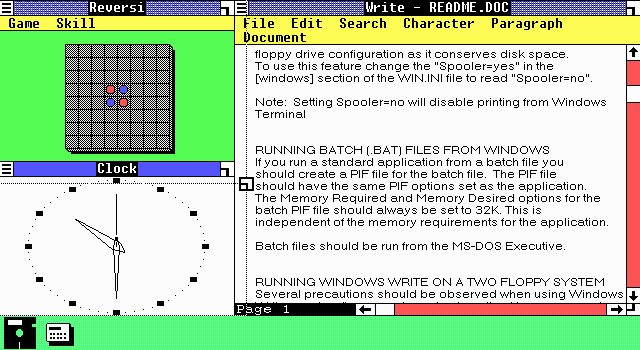
But did people like it? Hell, no! That’s why, since 2.0, Windows adopted the desktop metaphor that could be found in Apple’s System 1 (1984), which is a stacking/floating window manager.
The extremely popular Windows 3.1 had the ability to tile windows on demand:
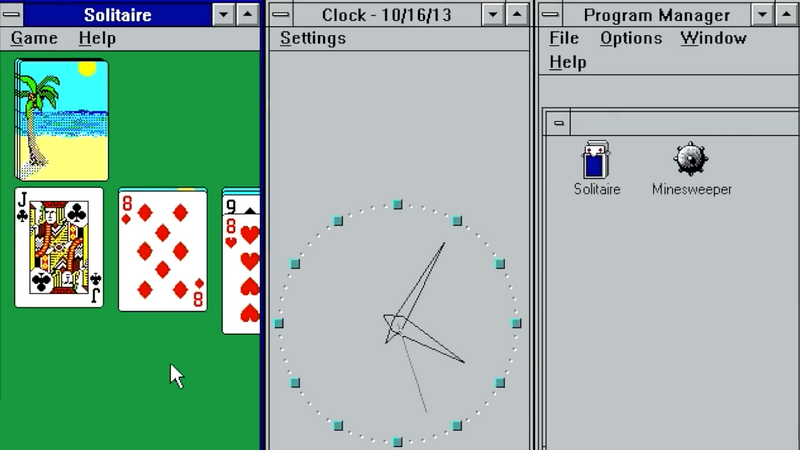
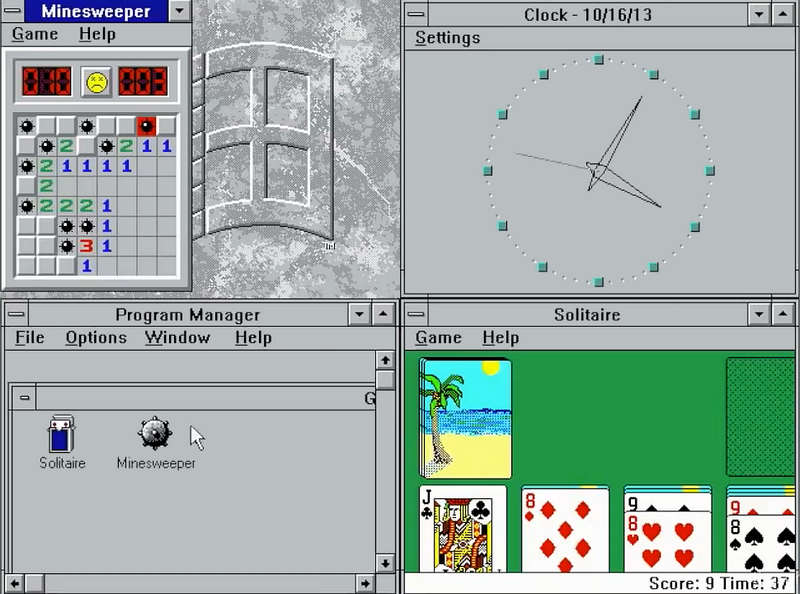
The layout was, obviously, predefined, and it worked best with 2, 3, or 4 active windows.
This ability was extended in Windows 95, when windows could be tiled horizontally or vertically, obviously on demand.

Windows 7 changed the crystal clear wording “Tile Horizontally” and “Tile Vertically” to the somewhat confusing “Show windows stacked” and “Show windows side by side”:
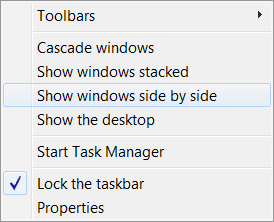
Even more confusing, Win7 had a feature only present in the Task Manager, when “Tile Horizontally” and “Tile Vertically” were still available, and they could be applied to the selected windows:
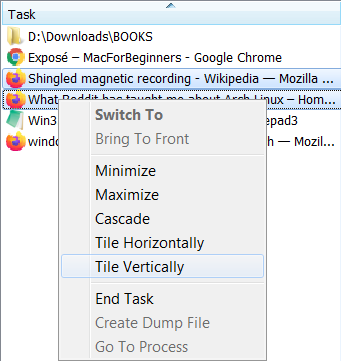
Win7 also implemented WinKey+arrows keybindings (WinKey+Shift+arrows for a dual-screen layout), which got somewhat changed in Win10, but which helped with tiling and snapping.
But do we have smart on-demand tiling in the window managers used by the major desktop environments in Linux and the BSDs? Can we right-click somewhere and tell the windows to tile? No, we cannot! What we can do is to use the keyboard and pre-existing or user-defined keybindings involving the Super (WinKey) key.
Go to that post of mine if you want to read what “poor man’s on-demand windows tiling” were available, at that point in time, in: KDE, MATE, Cinnamon, XFCE. Tile All Windows? Not in this life. And KDE was seriously lacking in this department prior to 5.27 (I suppose this is why Bismuth was born).
Oh, wait. I don’t have any Win10 at hand, but here’s a screenshot taken from How to do the same or similar “Show windows side by side” I have on MSWindows on Linux with xfce-4.12?

An answer pointed to xpytile, a Python script that offers automatic/dynamic tiling and resizing of side-by-side windows for Xfce.

Should you need some more guidance on the KDE 5.27 tiling:
- Smart windows: Tiling with KDE Plasma 5.27
- How do you use 5.27 Tiling?
- This segment of TechHut’s KDE Plasma 5.27 has new Tiling Features and MORE!
- Niccolò Venerandi (Nicco Loves Linux) has a number of videos (I really, really hate people who cannot write a blog post or article instead of making videos!), including a couple on this topic:
- 6 KDE Plasma Features you actually didn’t know (Feb. 22. 2023). Go to Part 5: Window Management.
- KDE Plasma TILING is BACK! (June 21, 2023).
BTW, Bismuth was mentioned by Nicco in his Dec 9, 2022 video KDE is FULL of TILING FEATURES! Well, not KDE by itself…
Speaking of undocumented KDE features: 6 KDE Plasma Features you actually didn’t know is the first time that I’ve found useful info in one of Nicco’s videos! Because, indeed, KIO Slaves (renamed to KIO Workers in KDE6 because of wokism, cancel culture, and mental retardation) and KRunner aren’t properly known by the end-users. They aren’t well advertised, so most users don’t know what they can do with them. I wonder who could have written some documentation—a KDE developer, maybe?
Nicco also claimed: I Implemented GNOME’s Best Feature in KDE Plasma (May 17, 2023). I watched the first 7 minutes of the video, and I understood exactly NOTHING. This guy cannot explain what the fuck he is talking about to those who are not using a specific feature or specific gestures that are supposed to improve productivity. As none of the tablet-centric, specific designs of GNOME make any sense to me, maybe this is why all this crap failed to convey any meaningful message to my brains. (GNOME people seem to be more productive with fewer features in their file manager, and I mean fewer features than in GNOME2—specifically, without a Compact List View!) Note that he doesn’t even name that “best feature”!
OK, this time there is a text transcription on his blog. There are no drawings or screenshots, so it still made no sense to me. “1:1 gestures. If you swipe up you zoom out from your desktop and all of your windows move into a grid; and if you yet again swipe up, you get to see all of your desktops with all of your apps and all of your applications.” Why would most people do that? Swipe? I’m not using a tablet! And touchpad gestures are a PITA. Besides, most people only use one desktop, and many distros are configured this way (it used to be different in the past). OK, the feature is called GNOME Overview, but there is no official documentation page for that. It must be sooo very intuitive to GNOME users, the same users to whom a Compact List View in Nautilus (Files) would have been an annoyance, as their tiny brain can only accommodate two folder views, not more.

Let’s introduce another annoying YouTuber: enter Brodie Robertson, and his April 9, 2024, KDE Plasma “Tiling” Is Neat But Isn’t Tiling:
If there’s one thing I’m an expert in it’s tiling, and I’m here to say that what KDE Plasma does is not tiling, however that doesn’t mean it’s bad and it can be made much better even without implementing tiling.
Oh, my. An expert in tiling.

On the one hand, he’s right. But then, he isn’t. He pretends to know some “true definitions” (given to him by whom?), such as: manual tiling is what i3 does, without any predefined layout, so if what KDE does is not automatic tiling, it’s not manual tiling either. (As per Wikipedia: “Tiling window managers that don’t use layouts are called manual tiling window managers.”) I suppose automatic tiling is what ratpoison, xmonad, dwm, bspwm, and awesome do.
But Wikipedia’s definition only applies to tiling window managers, not to stacking/floating window managers that have the option to tile on demand! So everything, from the on-demand tiling in Windows 3.1 and 95 to what KDE 5.27 does, lacks a “proper” definition. So let’s call them customizable on-demand tiling, because it’s fucking tiling either way. End of story. And go fuck yourself, buddy.
Here’s another YouTuber complaining that KDE is not i3: KDE Plasma Tiling – Why Is It Not Better?
The fans of automatic tiling are typically Arch users who use a lot of terminal windows simultaneously, so they don’t care much about their shapes, sizes, and placement. Such people are a tiny minority of this planet’s population, and if more people start migrating from Windows to Linux, such fans of automatic tiling will become even more of a minority. Why don’t they use their beloved tiling window managers instead of the stacking/floating window managers from the major desktop environments?
Tidbits on KDE 6.1
This Brodie guy likes being unhappy: KDE Plasma 6.1 Will Change My Life. Or happier, it’s hard to say.
Some of the changes introduced by KDE 6.1 are fine, a few one are not, at least IMO. Some are even dumb. As for “Reopening running apps on startup”, this is concerning Wayland, as X11 already had this since 2016, via ksmserver.
I’m now of the opinion that KDE6 should have been a completely new branch (or is it an epoch, in Debian lingo?) of KDE, so that KDE5 and KDE6 could be installed simultaneously on the same system, and the using of either of them be chosen at the SDDM level. This should have been possible, as they use different Qt versions, so their libraries wouldn’t overlap. Why wasn’t this even considered? Maybe it’s because people at KDE e.V. think like those at Microsoft Corporation or those at Apple Inc., meaning they are certain they know best about what we, the users, need or want. KDE 5.27 is already an LTE release. I wonder whether it will eventually get some kind of fork, à la Trinity Desktop Environment or à la MATE. That would be useful, especially if we’ll be able to run X11 for years to come; Wayland is crap.

Here’s another guy, Nicolas Stouff from The Linux Experiment: Plasma 6.1: the BEST LINUX DESKTOP (in my opinion).
As it happens, most of his criticisms are valid! Once you skip the first 2:29, you’ll find a rather worthwhile rant about what’s good and what’s not yet so good in the visual changes introduced by KDE 6.1 (he even bothered to check the different radii for rounded corners). I can’t wait to see how many of them will have been noticed by Dedoimedo, once he writes that 6.1 review promised here (“6.1 review coming soon”).
When someone thinks—at least in part—like me
Brodie Robertson, that über-annoying guy: The Most Uncomfortable Truths About Linux (May 17, 2024). No, this is not a must-see, except from the idea mentioned at about 5:35:

This goes well with my complaints from the chapter (or section) The worst design decisions in Linux. The “right” design is not easy to envision, as “immutable + Flatpaks + snaps” would lead to a lot of wasted space, but the system-wide dynamic linking is a huge hindrance.
💡 OK, here’s an idea: even in non-immutable distros, all non-system apps, especially those with a GUI, should be statically linked, so they could easily be upgraded. There are already many statically linked 3rd-party programs that come as .sh or other kinds of binaries, such as Calibre, a number of VPNs, Softmaker Office and FreeOffice, and many more. This would, of course, take more space, but such packages would have the advantages of Flatpaks without being Flatpaks!
I don’t agree with many ideas of this Alex T. Jensen (who prefers Windows), but again, some of his ideas are also mine, and I exposed them in the aforementioned #longread! A quick sampler:
Often Linux users will state people prefer Windows because Linux is “too complicated”, but there are many technical reasons to prefer Windows, especially for desktop use. One example, Linux lacking a stable driver interface is a huge issue both for users and developers.
— Alex T. Jensen (@alextjensen) May 6, 2024
A stable driver interface would do a lot for Linux on desktop adoption. I hope the maintainers change their mind at some point instead of calling the idea nonsense. https://t.co/wwH1LG0PIf
— Alex T. Jensen (@alextjensen) May 6, 2024
💡 A stable driver interface that would allow out-of-kernel drivers in Linux? Over the dead bodies of Linus Torvalds and Greg Kroah-Hartman! Here’s what their fucked-up arguments are:
The very good side effects of having your driver in the main kernel tree are:
- The quality of the driver will rise as the maintenance costs (to the original developer) will decrease.
- Other developers will add features to your driver.
- Other people will find and fix bugs in your driver.
- Other people will find tuning opportunities in your driver.
- Other people will update the driver for you when external interface changes require it.
- The driver automatically gets shipped in all Linux distributions without having to ask the distros to add it.
As Linux supports a larger number of different devices “out of the box” than any other operating system, and it supports these devices on more different processor architectures than any other operating system, this proven type of development model must be doing something right 🙂
Yeah, sure. The not-so-good side effects include:
- You need a new kernel to have a new piece of hardware supported, which is usually not possible in LTS distros. When it’s possible, you have to wait 6 months for the next distro release, which might still not include the kernel version you need. Unless, of course, you’re using Arch, Manjaro, Tumbleweed or even Fedora, which is keen on upgrading kernels despite not being rolling-release (at least, not officially).
- The kernels are coming “out of the factory” at an insane rate, which means they can’t be tested properly, and every major release comes with unbelievable bugs and regressions.
Definitely what was intended, right?
Rants about this and that, freestyle
Sorry, but here’s yet another YouTuber, Logan from Tek Syndicate: Why I Can’t Use Linux – My Top 3 Reasons (June 15, 2024). In brief:
Reason 1: Gaming
Reason 2: Creative Apps
My Most Important Software Ever: FL Studio
Video/Photo Editing: DaVinci Resolve learning curve (instead of Adobe Premiere)
Reason 3: Foobar2000 (my music player)
Reason 4 (bonus) Fussing, fussing, fussing!
WTF. Foobar2000 is crap. I don’t care about gaming (in my times, there were fabulous MS-DOS games and even some Win95 games that used to run excellently on the extremely modest hardware of the time, so I don’t understand today’s cretinoid games that require a nuclear power plant for the GPU to run), but there are solutions for most of them. As for FL Studio…
…he complained about it here too: Windows 11 24H2 is WORSE THAN Windows 8 | RANT:30 (May 10, 2024).
First of all, Win11 isn’t good because it’s designed for “what’s good for a tablet”? Wow, if only the GNOME nincompoops had realized that!
At about 21:09, he complains again about FL Studio. I added the following comment, which was (obviously) deleted:
You’re like a whining old hag with your FL Studio. Stop polluting your videos with crap. FL Studio works perfectly in WINE using Bottles, you dumbo! Here: https://usebottles.com/app/#flstudio
Video Proof: https://www.youtube.com/watch?v=xFJPTzM-qjk
Are you f-ing retarded?
Most such YouTubers are blatant incompetents that use your time to monetize their stupid rants.

Let’s move to The Weirdest Linux Bug Ever Discovered by Brodie Robertson on June 4, 2024. No, I didn’t watch the video, and I cursed the author for not providing links in the description.
Synopsis:
- Ubuntu Bug #255161 reported for cupsys on 2008-08-05: I am unable to print from open office, I tried reinstalling open office but it did not work. I use a brother mfc240c printer and I am running Hardy. Printing from other apps has not been an issue.
- It got on Apache OpenOffice (AOO) Bugzilla – Issue 92946 too.
- Make sure you read the Comment 28 for bug 255161.
- It took them a while to realize the actual bug was with the package
file, and it was already reported on 2008-07-15 as Ubuntu Bug #248619: file incorrectly labeled as Erlang JAM file (OOo does not print on Tuesdays).
Indeed, the bug meant that no document could have been printed on Tuesdays! It affected no less than four Ubuntu releases: Hardy 8.04 LTS, Intrepid 8.10, Jaunty 9.04, Karmic 9.10. Unbelievable!
Bonus: Print this file, your printer will jam.
Statistics and rankings
Let’s go back to Brest (Bretagne). Nicolas Stouff has some stuff for you: THIS is what the LINUX COMMUNITY uses?? Based on a poll taken by 9532 people from his audience, the results revealed a number of surprises. I didn’t watch the video, but I used the provided CSV.
- Desktop Environments: 30% were using KDE, 29% were using GNOME (with or without extensions) but 34.6% if including Ubuntu’s variant, plus Unity and Pop!_OS’s COSMIC, 3.4% XFCE, 1.2% Cinnammon. Only 0.68% used MATE, 0.37% used LXDE or LXQt, 0.27% Budgie. However, 21.5% use a tiling window manager, a surprisingly large value!
- Distros: 28.9% Arch and derivatives (but not Manjaro), 22.4% Fedora and derivatives (Nobara), 9% Ubuntu, 6.9% Ubuntu derivatives (Zorin, Tuxedo, Pop!_OS, but no Mint), 6.2% Mint (6.9% if including LMDE), 5.2% Debian stable (7% if including testing and sid), 3.7% openSUSE, 2.9% Manjaro, 1.5% Gentoo.
- 9.7% were using an immutable distro.
- KDE was used in: Arch and derivatives 10.6%, Fedora 5.1%, openSUSE 2.4%, Debian (all branches) 2% (1.4% if only stable), Kubuntu 1.9%, Manjaro 1.6%.
- CPU: 50.2% AMD, 48.8% Intel, 0.9% ARM.
- GPU: AMD-only 35.7%, Intel-only 22.4%, Nvidia-only 21.6%, hybrid 19.2%.
- From those using Nvidia drivers: 87% proprietary, 13% nouveau.
- Gen Z (Alpha too) won: 66.25% Wayland, 33.75% X11.
- 28.1% never use Flatpaks, 54% never use AppImages, 83.4% never use snaps (especially as Ubuntu sans derivatives is only used by 9%).
- Browsers: 67.5% Firefox (76.9% incl. derivatives), 8.3% Brave, 6% Chrome, 3.2% Vivaldi, 2.6% Chromium.
- Polyamory: 63.4% are Linux-only, 34.2% dual/multi-boot with other OSes, 2.4% dual-boot between distros.
- Fidelity: 33% (almost) never distro-hop.
One obvious conclusion: most Linux Mint users don’t bother watching YouTube in quest of opinions on Linux! That’s ironic, as this guy values Linux Mint as much as he values Fedora!
I’m not sure that I ever mentioned it, but I hate how he’s sometimes giving the wrong reason to like or dislike a distro, a desktop environment, whatever it is. Here’s the most recent example: Ranking Linux Distributions for 2024: a tier list for my use case!
You don’t need to watch the video if you know these logos:

Quick comments:
- Ranking Criteria: There is no rating system and no score, so ranking is overly subjective.
- Linux Mint is great because it “fixes” Nvidia. Well, it’s LTS-only, so they had plenty of time to do this, especially as they’re extremely slow to rebase once a new LTS is released.
- Most mainstream distros are “average” (let’s not question that, except that Mint is also mainstream, and it’s overrated). But he never considered the RHEL clones, which is a considerable flaw. 👎
- Zorin is average? Zorin is for nincompoops!
- Fedora is great for production?! With the kernel changing every other day?!
- Manjaro: “no, thanks.” I understand the possible issues if and when using AUR. Otherwise, it’s pretty much stable, really.
- Sorry, but Tuxedo is not semi-rolling. It’s based on Ubuntu LTS. Only KDE is taken from neon. Everything else is damn old. And it’s very slow to rebase… because neon too is slow to rebase. But Tuxedo is one of his sponsors… 😉
- Pop!_OS: “no, thanks.” Very much agreed.
- NixOS: average. Agreed, I don’t see the point of it.
- HoloISO, which I never heard of, is for gaming only, yet it’s “great.” Va te faire enculer, mon pote. (Pardon my French.)
- He never thought of how stupid it is to use a distro whose desktop environment uses Files/Nautilus, which lacks a Compact List View. This is true for Deepin too, but it should have downranked other distros also, such as Pop!_OS, which was very popular a couple of years ago.
He, and many others, should read this, from which I quote:
I could never use GNOME because Nautilus is the only file manager in the known Universe that lacks a Compact List view. I wish someone at Red Hat would realize how ridiculous this is and how this makes them look mentally retarded!
A Compact List view is available in:
- Caja, the original Nautilus in GNOME2
- Thunar
- Dolphin
- PCManFM
- PCManFM-Qt
- Nemo
- Xfe
- ROX-Filer
- CDE’s file manager
- Windows File Explorer since Windows 3.0 if not earlier
A Compact List view is NOT available in:
- Files, the Nautilus version in GNOME3/4x
- Deepin’s file manager
- QtFM
‘Nuff said. But I’ll keep repeating it across the intarwebs until I see a single GNOME developer say, “Gee, why the fuck did we remove this view? Because we felt more than two views will be too many for our intelligent users?”
When in front of a computer, no matter the OS, I use my file manager:
- 70% of the time in the Compact View
- 20% of the time in the Detailed View
- 10% of the time in the Icons View
If I was forced to live without a Compact View, I’d rather commit suicide. You are not retarded if you, personally, don’t need to use a Compact View; but you are a retard if you decide that nobody else should need such a view!
Not everyone uses the Compact View (Compact List, whatever you call it) mode all the time. When dealing with images, the Icon mode comes in handy. When the details are important, well, the Detailed list is to be used. But when I deal with folders having hundreds or thousands of files, my productivity would decrease by orders of magnitude if I didn’t have a compact view!
Over and out.
LATE EDIT: Another tiling that is not tiling! (Or is it?)
I learned by chance that GNOME, that desktop environment that can’t do almost anything without extensions (and it can’t do anything right even with extensions), can benefit from a Tiling Assistant, which defines itself as follows: “Tiling Assistant is a GNOME Shell extension which adds a Windows-like snap assist to the GNOME desktop. It expands GNOME’s 2-column tiling layout and adds many more features.”
Funny thing, someone complained two weeks ago that it “works only with mouse cursor, neither touch or stylus input.” Oh, those GNOME users…
In Ubuntu 24.04, it’s called gnome-shell-extension-ubuntu-tiling-assistant. What a nice pretty name.
But it’s more snapping than tiling! Watch here and here.
However, there’s even more! It’s called Tiling Shell, a new GNOME Shell extension that offers “advanced tiling window management” (watch the videos!). It has tiling with snapping, resizing of the tiles, and a layout editor. Some users seem thrilled.
Because GNOME is sooo simple, the extension is actually called org.gnome.shell.extensions.tilingshell (Java-like schema), or tilingshell@ferrarodomenico.com (by uuid). This is important, because, to uninstall it, you first need to disable it at the CLI:
/usr/bin/gnome-extensions disable tilingshell@ferrarodomenico.comWow, GNOME brings so much progress that I can’t even! (macOS too requires a lot of CLI fiddling for things that should have been fully visual.)
Here’s a quick demo of Tiling Shell on Ubuntu 24.04 LTS, from this article. Nothing that KDE 5.27 cannot do, no extension needed.
But there are still ZERO desktop environments in which one can right-click on the taskbar (or somewhere else) and choose “Tile Horizontally” or “Tile Vertically” (Win95), or “Show windows side by side” (Win7)! How is Linux better than Windows?
Of course, ratpoison, xmonad, dwm, bspwm, and awesome can be used without a mouse or trackpad, which is great. They’re minimalist window managers. Most people need something else, and so it happens that on-demand tiling in KDE or GNOME is mouse-intensive, yet Windows versions from 30 years ago could do amazing things with two mouse clicks (one right-click, and one left-click). That power has been lost in decades of progress (duh).
LATE UPDATE: Tiling all the way!
Apparently, Tiling Shell v9.1 is worth mentioning: Tiling Shell Updated with New Keyboard Shortcuts + More.
Similar to other tiling window managers/extensions, you move the active window to a tile position (in the active tiling layout) by pressing Super (Windows) key keyboard arrow keys.
A good thing per se. A really good thing, actually. And custom tiling layouts can also be created.
In other, unrelated news, in an article about the new branding of System76’s COSMIC, a desktop environment that, I suppose, is meant to improve on the tiling features of Pop!_OS, I noticed the following screenshot:
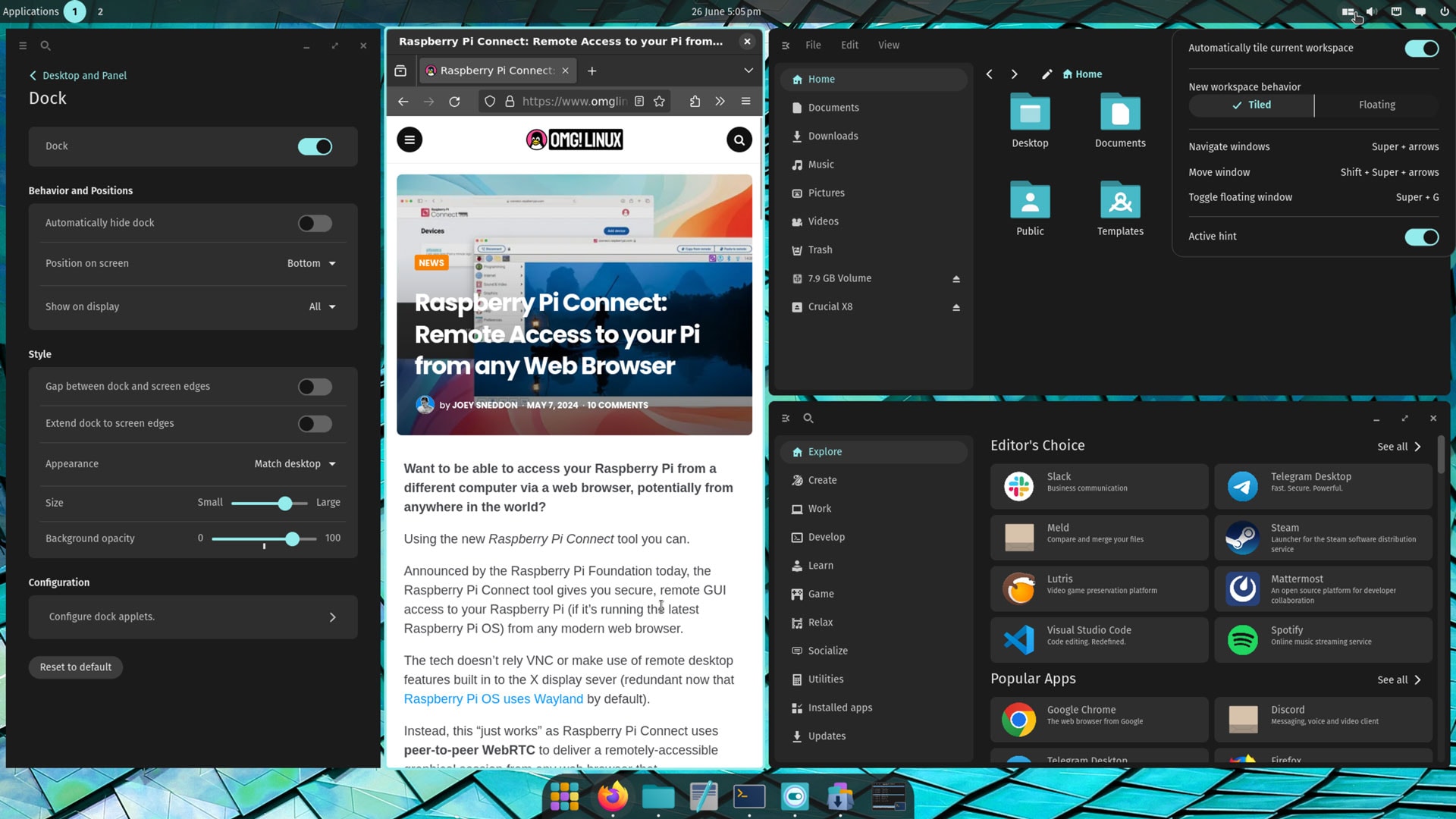
One more pretext for me to use the R-word. Why is everyone mimicking the retarded macOS? The dock is even ugly here, and it might not hide, as the tiling doesn’t cover it. So you have an entire band (strip, if you prefer) occupied at the bottom of the screen, but the left and right of the dock are completely unused. Why not use a proper panel, à la KDE?
Yes, I know. People who love the desktop metaphor introduced by Win95 are “OK, Boomer!” But forcing visual elements from Apple on us is not fair. I don’t want any global menus or docks.

Un bug bizarre et étonnant. Incroyable qu’il ait affecté 4 versions ! Incroyable !
Heu, hum 🙂
On lobste.rs, “the better Hacker News”:
Thanks for nothing. First, the comment wasn’t submitted on my blog, so talking to other galaxies is rude. Secondly, he couldn’t be bothered to notice that I’d rather die than use GNOME, and there are serious reasons for that.
But to the point: as a typical GNOME way of breaking people’s workflow, here’s the dumbest proposal from that article:
Reading the comments provides, however, a lot of food for thought. I can’t mention the many ideas worth analyzing. Here’s a funny one:
It looks like some people still don’t realize that GNOME Shell has been designed as if it were for tablets, or touchscreens! Productivity can indeed be improved by clever using of the keyboard, but that’s none of GNOME’s concerns.
But that GNOME issue includes another comment that I found funny:
It’s not a bug, it’s a wish!
One more thing. Reading those comments is how I found out about the scrollable tiling concept. As an example, PaperWM, yet another GNOME Shell extension. A defunct one, cardboard (video).
So many people are trying to invent irregularly-shaped wheels.
Kröhnkite, Bismuth’s predecessor, has been ported to Plasma 6, and works great. There’s also Polonium, which provides autotiling by managing kwin’s tiling mode.
Thanks, Ken.
Alex Lazar is nitpicking that study about the 8-second attention span he disagrees with.
That was not the main point, I’m afraid.
But if he really has a much longer attention span, he should have read the post from the first link, and the one pointed to somewhere inside.
Otherwise, he’s just a bulldog who’s stuck biting one’s buttocks, ignoring everything else.